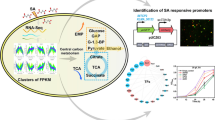Abstract
The sterol-acyl transferase encoded by the gene ARE2 was transcriptionally deregulated in the yeast Saccharomyces cerevisiae to understand its role in sterol storage and sterol enrichment. Our results show that sterols can indeed be enriched in yeast by enhancing the capacity of the cells to esterify sterols. ARE2 overexpression had no impact on the accumulation of the early sterols such as lanosterol, but influenced the later intermediates and the end product ergosterol. Thus an enhanced conversion of free sterols to their esterified counterparts may provide a tool to increase the overall sterol content of the yeast cell. We have previously shown that the overexpression of a truncated version of the key enzyme of the early sterol pathway, HMG-CoA reductase (HMG1), leads to an increase in the early sterols such as lanosterol and zymosterol. The simultaneous deregulation of both genes in one strain produces a cumulative effect in that both early and late sterols are enhanced. Karmellae-like structures can be detected when Are2p is overexpressed. Are2p therefore constitutes a new member of the karmellae-inducing protein family.
Similar content being viewed by others
Author information
Authors and Affiliations
Additional information
Received: 6 April 1999 / Received revision: 2 June 1999 / Accepted: 4 June 1999
Rights and permissions
About this article
Cite this article
Polakowski, T., Bastl, R., Stahl, U. et al. Enhanced sterol-acyl transferase activity promotes sterol accumulation in Saccharomyces cerevisiae . Appl Microbiol Biotechnol 53, 30–35 (1999). https://doi.org/10.1007/s002530051610
Issue Date:
DOI: https://doi.org/10.1007/s002530051610




